Ones and Zeroes
Earlier this summer, on the occasion of his first one-man show in Japan, American artist Takeshi Murata screened Damage Control (2007) at Tokyo’s Gallery Sora. A collection of his video work was selected for the Smithsonian Hirshhorn Museum and Sculpture Garden’s Black Box exhibition series (May 28 – September 9, 2007). An earlier video short titled Melter 2 (2003) was included in the Automatic Update group show, which also took place summer 2007 at MoMA, New York City. Murata recently completed an animated video for Mail Order Monsters, a group show at Deitch Projects in New York City (on view September 6 through September 29, 2007). The following interview was conducted in Tokyo on June 10, 2007.
You were talking a little bit about some of the differences you’ve noticed between the way the art scene is in Tokyo and the way it is in New York, or in London.
Well, my views of London and Tokyo are really peripheral. From an outside perspective, I know I’m not getting those details that are usually the most inspiring things about cities and about people. It’s interesting though: in Tokyo, we’ve seen similar kinds of artists, great artists that I like. But we’ve seen a lot of their work a lot of places that we’ve gone. In New York, there are so many artists and so many galleries, and it’s overwhelming how many people there are all the time. It almost seems that it’s also very separate, not so much maybe in New York, but in the U.S.—that art, the art world, is really separate.
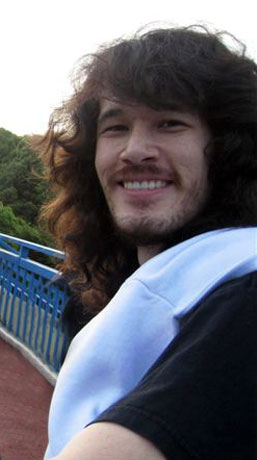
Separate from?
Just general life, you know. And here it seems, for better or worse, like it really is integrated quickly into mainstream culture. It seems like people, more people, are interested in art; but also that there’s some commercial aspect that’s difficult to understand, which is what you notice with the Uniqlo thing. It’s great that artists are so popular that they’re making designs that are in Uniqlo. Also, it’s crazy that it’s commodified to that level so quickly.
So you have mixed feelings about that type of assimilation?
I mean it’s weird. You don’t want to just make artwork for the galleries and for a really small audience. You want it to be broader. But the outlets in the U.S. are not quite as open or something. There’s not that merging of commercial and fine arts, so the closest thing would be, for example, that a couple of my friends have gotten pilots, shows, on commercial stations. But that’s the limit of what you can do, you know.
Seven or eight years ago, you were interested in doing that type of commercial work too, right? Looking at the new work, I’m curious about your move into ‘fine arts’ and away from very literal character animation.
I have a love-hate relationship with all the commercial stuff because I was interested in making work that appealed to as many people as possible and that could say something that would be accepted commercially. After doing that for a while, I got so frustrated not getting any response. So I was just like, To keep pursuing this by trying to mold my work in a way that is more acceptable or whatever—just marketing my work—is pointless. I started making my own work, and it fit more in the gallery and fine art world. It was less narrative, I suppose—a little bit. And, you know, before I really started getting into showing at galleries, I was trying to sell tapes and stuff, and no one wanted to buy abstract animation—even for like five bucks. I’d make VHS tapes and try to pawn them around, and no one was interested. Then galleries were, and collectors are. That’s how I got much happier showing this way.
And this way people are actually seeing the work.
Yeah…still, my big audience is a very small audience. If I have a lot of people seeing it, it’s about twenty people. But, I remember seven or eight years ago, I’d go out with my friends Jon Brzyski and Paul Kim to do these presentations at Showtime and other cable channels. We’d show them these weird-ass animations we were making: just unconnected shorts—they made no sense together. There was this harlequin that would go around on screen presenting them. And pitching that in a Showtime office was so funny because people just looked at us. There was no response. You know, we’d worked a long time, and we’d have to head home saying, ‘This stuff’s never going to get shown.’
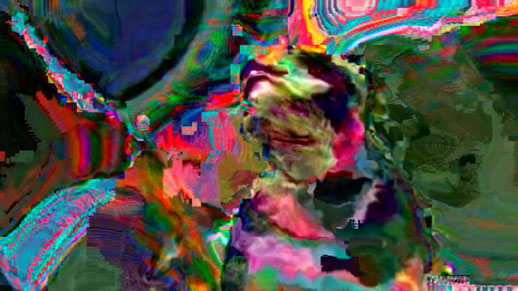
After I watched the piece at Gallery Sora last week (Damage Control, 2007), I felt that you’d retained a narrative quality. It’s not completely experimental—
Well, ‘experimental’. I mean, I think you can have narrative work that’s experimental. But at Taka Ishii, they were open to anything. Unless you’re super famous commercially, that might not ever be true in the U.S. Your work still has to fit within a certain kind of structure. Because I gave up on the whole commercial world, I honestly can’t talk. There are people like Devin Flynn, who’s not bringing it down to any level for anybody; maybe his work is more what people want to see on the cable channels, whereas I don’t think my work really is.
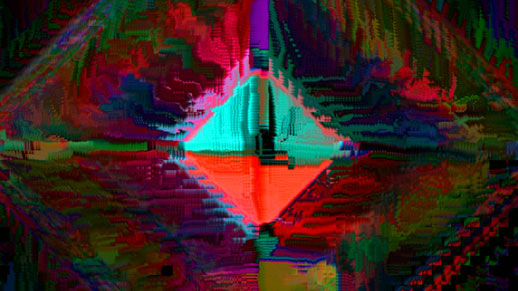
Do think in terms of narrative at the outset, or do you begin with images that appeal to you? While I wouldn’t say that there is a clear narrative in your video at Sora, its progression is more linear than non-linear, like a story—a visual story.
I like that aspect of it. Linear things just become narratives. Doing a linear-like beginning-middle-end piece for a gallery is kind of weird because people walk in at the middle or end all the time. There’s no starting point. Initially, I didn’t want to do that. I wanted to do completely non-linear looping animations, but I realized that, for me, it was much more rewarding not to. With a time-based medium, it kind of tends to become narrative. When I was trying to fight that with a looping non-linear animation, it didn’t work that well. I’d still try to push towards a kind of narrative, towards some sort of structure in that way. And I think that’s just how we understand time: everything’s like a little story…in a way…
Music is very important in your work too.
Yeah, that’s made by Robert Beatty. On the last couple of projects, we’ve worked together. This time, for the Tokyo show, I sent him clips and he sent me sound back that I felt really gelled. The sound he sent was working so well with this narrative structure that was developing. I talked with him about it, and we used some of that sound for the beginning part. It’s that jarring cello sound that I wanted to have as this peaceful, spacious fog. Anyway, we built the narrative feel together.
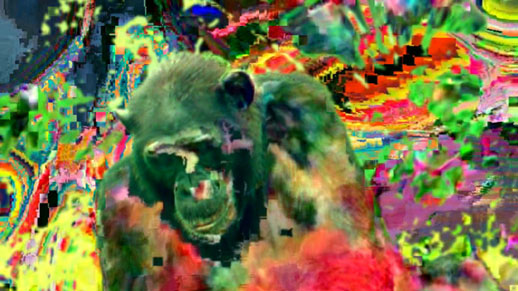
Now what about the imagery you use? In this one (Damage Control, 2007) there are chimpanzees and leaves. How do you decide which images to include? Is the choice based on loose association, or on some narrative quality you find particularly engaging?
It’s free association, I think. I start with images that are interesting. This one was a mix of this abstract geode animation I was working on which already had its own kind of direction. I wanted to pull more representation into it, or figures. So a lot of it was just trying to figure out what would work with that, but not really thinking about narrative at all—just thinking about what things went together visually, about how I could make those things pull together in a single composition.
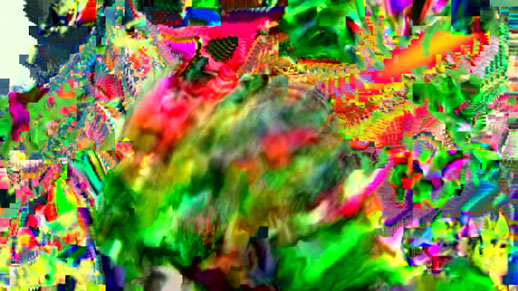
Sounds like a difficult process.
That part’s a little difficult. But generally it’s nice because with video, unlike other things, I can change everything. Initially with this video, I was using really geometric forms with Ultimate Fighting Championship video. I thought it would work and it wasn’t working at all. I got much more interested in the way these animals were moving in the ring. But I wasn’t interested in the personality of the fighters, or their characteristics. I wanted to have that recognition of faces and bodies without the personal recognition of what their expressions were. Chimpanzees had that perfect blend because they’re still figures that you can associate with, and recognize, and then bring things to. They don’t stop you the way that some dude with a mustache, and giant tattoos, and who’s ripped does. You bring all this baggage to those guys.
That’s interesting because in the other one at the Hirshhorn, the Pink Dot (2006), you used a very identifiable kind of pop image.
Yeah, that was a whole different thing I was trying to do. With that one, I was interested in taking things away from an absolutely iconic figure to try and make the viewer see it in a different way. So I wanted that instant recognizability of Sylvester Stallone in Rambo, you know.
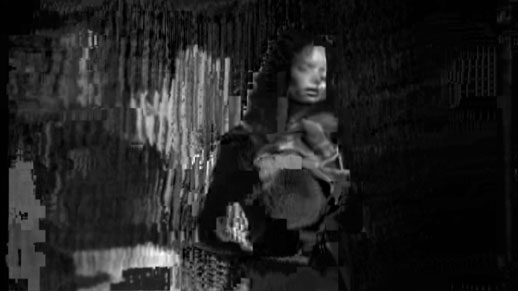
Another key element in your work is the technique that you’ve come up with; you can produce so many different effects with it. For example, in the black-and-white one with Barbara Steele, Untitled, (Untitled Silver, 2006): since it’s a film, you get this really photographic quality. But with the one that’s showing now (Damage Control, 2007), the colors give it that painterly quality.
It’s from—like I’m sure a lot of people have—when you watch a video online and it gets fucked up somehow, and the colors bleed together, or the face disappears in a weird way. Generally, they always try to put safeties in web video, so when a download’s corrupted, that distorted image shifts back to normal pretty quickly. I wanted to make video of those little chaotic moments. I thought they were the best things, so I started out using them really directly. I guess I was trying to exploit how far you could take things and break them apart. As I’ve been working with those little moments more, I’ve been trying to pull more out of them and add my own to them in the finished animation. It’s a way of working that’s ideal for merging images together. As far as technique goes, it makes a great muddy surface that you can drop footage generated from other sources into; it’s crazy to watch that imagery melt away into other forms.
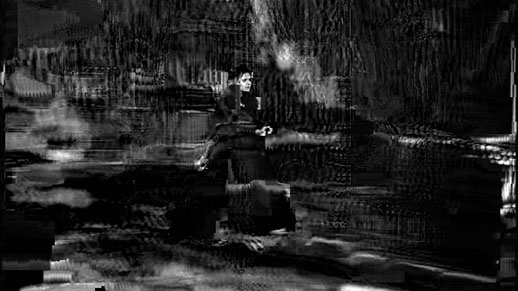
That relates to another question I have. I’ve noticed your work discussed, written about, in these ‘end-of-an-age’ terms.
The end? I haven’t heard ‘the end’—that’s cool. Well, it’s funny. I accept any of it because it gets the work shown for whatever reason. I want my work to be interpreted in different ways. I don’t want to force things down by saying, ‘This is a conceptual piece about…’ It’s difficult with shows that are themed by the medium used to make the work because that’s not the most important thing of any work. You know, if the medium’s the central thing of the work, it’s going to be really boring obviously.
Besides, artists have always exploited technology, whether it’s a camera obscura in the seventeenth century, or whether it’s photography in the nineteenth century. That’s just how it’s done.
And I think there’s always some skepticism to those technologies. They change what happens with everything; they’re difficult to grasp. I understand the real skepticism, or criticism, or also over-embracing of them. You know, technology can be so strong…but it’s still a tool that a human hand has to be brought to or there’s nothing in it. A lot of technical ‘wow’ can make that emptiness easy to hide; the same was probably true with photography. I mean, I’m sure the first photographs were amazing things for people to just look at. So there is that aspect of computer-generated work. As we get more comfortable with how it works, then we’ll see through it and see what’s actually being made with it. The fact is, you have to trust in how you’re looking at something—really directly and without any history—and that’s hard I think.
Does technology change the way you think about things?
I think it does, actually. I mean, ‘digital’ is a crazy word because it encompasses way too much. I still think of ‘digital’ as ones and zeroes. It doesn’t mean a culture or anything to me. But think of how photography changes the way we see everything; even today, Muybridge, I feel, is pretty important for people to watch in terms of seeing movement and seeing how things function. It’s just a way of understanding everything else better. And I think that sort of understanding can come out of digital video and things made with a computer, with digitally generated imagery: there’re all different ways of looking at time through work constructed that way.
Whose work have you been interested in lately? And try to tell me why.
Ah…I’ll go with what I’ve been into ‘most recently’. Yesterday Fran [painter Francine Spiegel] and I went to the ICC in Tokyo Opera City. The space there is funny in its own way from what we were talking about before; because it started around 1997, there’re still remnants of what digital and futuristic art was, like touch screens and…What? ‘Somewhat’ interaction. It’s really kind of removed. You don’t feel like you’re interacting with anybody. But then they have this great archive of video. This is such a lame thing to say being in Japan, but in their archive are a lot of New York artists. So I sat there and watched a lot of Steina and Woody Vasulka’s work. I think to answer your question of why it’s inspiring…well, one of the things I was thinking about is how active they were in making the community in New York City important. Right now, it’s difficult to find people in New York who have time to tinker around with video and not make a living from it. It’s either kids in school or I don’t know who else. Anyway, going back to the Vasulkas, with Steina especially, the level of experimentation from work to work was just great. She’d do things like the first kind of bit-mapping of imagery. She’d break a photograph—a video image— down into 16 tones, and then map those 16 tones into different channels, into patterns. A cantaloupe is this one: all the different ways that you can look at this simple thing through really early image processing. It’s the most minimal thing, but to me is super-inspiring, and in a weird way, because it’s so difficult to find and see that work. I should be familiar with that work from like fifteen years ago.
Let me get your thoughts on this John Berger passage from 1979: “I now believe that there is an absolute incompatibility between art and private property, or between art and state property—unless the state is a plebeian democracy. Property must be destroyed before imagination can develop any further. And thus today I am more tolerant of those artists who are reduced to being largely destructive.”
Largely destructive? That brings to mind what my friend Jon Brzyski said one time. He made this drawing and I think he handed it to me, or maybe he’d come up with this title for it. Anyway, all he said was, ‘Now there’s another piece of shit in the world’, which does have something to it—like, Do we need this? It was really funny, and you do wonder about objects that way.
I think what Berger’s writing about too is the idea that the ‘commodifying’ you mentioned earlier hinders imagination and creativity.
Yeah, that’s understandable. I was able to sell the first video I made and get rent money for a couple months. Obviously, it was difficult not to have that in mind while working on the next one. In the U.S., there’s such a direct connection to how well you’re living and how much money you’re making. That’s definitely a hindrance. At the same time, I wouldn’t want the government supporting me: any kind of institutionalized support is going to most likely be conservative, to most likely have its own agenda—all those things that do hinder personal creativity.
A lot of people you know have been working their way through the gallery system. Do you think market pressure has had a negative effect on their work?
Right now’s a difficult time for a lot of people I know. You have to have a lot of things balanced to make and show good work. You have to really hustle and be a good businessperson and then also have time to work, pay the bills, and do all this other stuff. I have a lot of respect for anyone who can do it at all. Maybe your question brings us back to the point in that quote when Berger’s talking about ‘a plebian democracy’. I don’t fully know what a plebian democracy is, so maybe this is what he’s saying, only in smarter terms: but if your work isn’t recognized by the people who you’re trading with…you know, if I want some food from these people to survive and I’m making abstract animation, they’re going to tell me to fuck off—and rightfully so. That’s the basic problem with what I’m interested in doing. Still, people who buy my work are really supporting me. They’re interested in what I’m doing. They don’t know if what they’re buying is going to have any value. It’s a new thing. They’re buying a piece of paper that says they now own ‘an authentic edition of this video’, which—who knows? It might have no value. They realize this, but they’re willing to put money towards it. That allows me to make work. On the other hand, I’m not going to bitch if people aren’t into what I’m doing. I don’t call that taking away from creativity. It’s just that there are different ways of expressing creativity. If my true aim was to survive off my work, I’d sell something people wanted on a mass scale; I would have to find a way of expressing creativity in making…car parts or whatever—it sounds stupid, but, you know, making something that’s useful to people in a really direct way. I’m happy that I can make things people find useful in a very strange, off way.
Let me rephrase the question slightly: Do you feel that the pressures of galleries and so on make it hard for artists to advance into new territory?
I think it depends on the artist. I feel like in the history of work you can see that artists get under pressure and you can feel the hindering of creativity that Berger was talking about. I guess it’s what you want out of showing, out of a gallery, out of all those things. There’re so many variables. I love showing, I love being supported that way, but it’s also not the most important thing to me. The most important thing is enjoying what I’m making, and when that stops happening then I know I need to do other things. In all honesty, it wasn’t so bad what I was doing before: just working and trying to make video on the side…I guess the difficult, other side is that it’s very subtle: the pressures of the system, of galleries, of showing that way, are a little more subtle than I’d imagined. They’re not as direct as, like, trying to make more work because people want to see more work. I haven’t ever had anybody tell me they want a certain kind of work or anything. It’s never been that specific. But, I know that people want to see more work, and I can show it in these bigger spaces if I produce more work. Since there’s great opportunity in that, I try to make my work faster. For better or worse, that means I might have less time to experiment. Then the whole process becomes a matter of balance.


